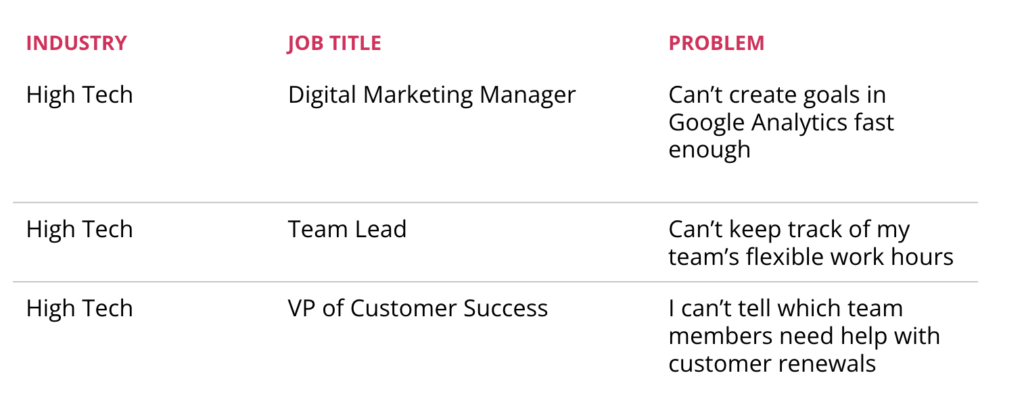In our last blog post we discussed why a minimum viable audience will help startups stay focused and have more success in getting to market. Now that we know the benefits of a minimum viable audience, it’s time to start creating one. In this blog post we’ll explore how to create a hypothesis for a minimum viable audience and then how to test and optimize it to nail down your go to market strategy.
Step 1: Create User Stories
In the same train of thought as doing user interviews, creating user stories for go to market strategies will give entrepreneurs the ability to visualize how different users can benefit from the product. When creating these user stories, we would recommend starting with the problems you’re potential users could experience. We’ll be focusing on users first because the users may not be the people paying for your product. For example, if your product caters to kids the people do paying for your product will be their parents. If your product is for particular business users the head of their department or their company may be the payer. By focusing on the users benefiting from the product first, you’ll make sure you’re delivering enough value for them to ask whoever is in charge of the budget to buy the product for you.
Creating user stories will differ if your business is B2B, B2C, or B2B2C. Here are a few tips for creating user stories for each business type:
B2B
B2B businesses may seem complicated. The main thing to remember is that everyone, including directors, Vice Presidents and even C-level executives are still human. They still have challenges they need help solving, and they will still talk to people who can move the needle for their businesses. At Albaloo we suggest founders start user stories by thinking of the industry, job title, and problem the user is having. Below, you can see a few examples of user stories:

B2C
B2C companies will slightly differ from B2B companies. When building these user stories, we recommend starting with a demographic, behavior and problem. Below you’ll find examples of user stories for B2C companies.

B2B2C
Companies that have both types of users will be pretty tricky to create a product for. The easiest way to start a company that has both a B2B side and B2C side is to focus on one side of the business first. What part of the platform will drive the most value? For example if your business will rely on niche advertising to drive revenue, you’ll need users and content before businesses will want to advertise for it. In the same idea, some businesses can make more revenue with boutique services that use their product before being able to have a product led growth model. For B2B2C companies, find which side of the business you can help the most and then write user stories for that side of the business.
Platforms
Along the same line as B2B2C companies, platform companies will have similar challenges. The main differentiator between a platform business and a B2B2C company is a platform business will have two sides of an app where users interact with each other. Think of Upwork, where freelancers looking for work and businesses looking for help can find each other. Instead of spending a lot of money on trying to attract users on both sides of the platform, think of ways one group can help recruit for the other group. In the case of Upwork, can businesses looking for freelancers share their job posts on other websites to bring freelancers to the platform? That would be one easy way to reduce the need of bringing freelancers to the platform. When working on a platform you’ll need to write user stories for both sides of the platform, since the platform won’t work with one side of the equation missing.
Step 2: Interview the Users
Now that you have your front runner hypotheses, it’s time to do some user interviews to see how your thoughts line up with reality. The trick to interviewing users is to make sure you’re not asking biased questions. For example, if you think someone’s process is manual and hard to manage you can’t ask them that exact question. First you should ask them about a particular process and all the steps they take to complete it. Then you can ask them how they feel about it. Do they hate it and have to do it for a particular reason? Do they think that’s the best it’s going to be? Is there regulatory or compliance challenges in the way? Once you uncover these insights you can ask them how they’d like the problem to be solved. This question will see if anyone will validate what you’re building without you leading them to it. By asking a series of open ended questions you can learn more about their thought processes and day to day challenges they’re facing. Gathering this information can help you find patterns and trends amongst prospective users.
For Companies Who Aren’t Launched
When you’re done asking prospective users all the questions about their processes and lives, the next step is to show them what you’re working on. All you need is a prototype or even wireframes of different screens. See how they would react to it, and if they can intuitively use what you’ve built. Ask them if they would use it and pay for it. Also ask them how they would buy it. For consumers, the buying process will be much more straightforward than a B2B app. If you get a resounding yes of using it and buying the product from 5 users on the B2B side and 10 users from the B2C side, then you can move onto actually building the product and building that audience. If you’re not getting that response, you’ll have to take the feedback for improvements and then interview the users again. Once the first set of users give the resounding yes, find another group and make sure the feedback holds to a larger group. This process needs to be repeated over and over again until the majority of people you talk to will give the resounding yes for buying and using it. Then you’ll have everything you need to building a product people want.
For Companies Who Have Launched
If your company has launched then you can interview the customers you already have. Instead of asking them if they would use your product, see how they’re using it today. If the use cases have matched up and are the same throughout, you’ve created a minimum viable audience! If they’re all using your product in different ways to solve a problem, you need to go above and treat your product as if it hasn’t launched it, except for the end where you can show them your product instead of a demo. Can you find an audience that can all use your product the same way for the same use case? Then focus on them and sell there. If not, you’ll need to figure out which group of prospective customers can get the most out of your product and are also the largest group of prospective customers.
Step 3: Create a Hypothesis
Once the interviews are complete, everything else becomes easy. Review the feedback you received from users and create a report for yourself and your team on your learnings. What do your users who gave positive feedback have in common? Can you slice and dice them into different groups based getting more granular than the original segment? If yes, make the group as granular as possible. Maybe you’ll find that everyone who had a particular problem all used the same tool. Other times it’s a particular process that exacerbates the challenge. These insights will make it easier for your team to qualify candidates and find success when we start testing the hypothesis.
Step 4: Test the Hypothesis with Sales
The fastest and most cost effective way to test the hypothesis lies with outbound sales activities. Try cold calling a list of 100 strangers who match your target persona and see if they all experience the same problems as the people you interviewed. Then, try to sell to them. Test out your sales process and see what they need to actually get started. It’s more than likely that you’ll have to iterate on your messaging and practice navigating the conversation. Once you’re able to get 2-3 meetings a week on cold calling you’ve found your minimum viable audience! After you’ve gotten sales in the door, you’ll be able to see how the customers behave with your product or service and really hone in on the differentiators that separate your best customers from everyone else. With that knowledge you’ll update apply that messaging to sales and marketing campaigns including your website, marketing materials, and sales outreach.
The fastest and most cost effective way to test the hypothesis lies with outbound sales activities. Try cold calling a list of 100 strangers who match your target persona and see if they all experience the same problems as the people you interviewed. Then, try to sell to them. Test out your sales process and see what they need to actually get started. It’s more than likely that you’ll have to iterate on your messaging and practice navigating the conversation. Once you’re able to get 2-3 meetings a week on cold calling you’ve found your minimum viable audience! After you’ve gotten sales in the door, you’ll be able to see how the customers behave with your product or service and really hone in on the differentiators that separate your best customers from everyone else. With that knowledge you’ll update apply that messaging to sales and marketing campaigns including your website, marketing materials, and sales outreach.
Final Thoughts
Creating a minimum viable audience takes a lot of time and energy. By waiting to create a product until you define an audience, you’ll be able to save a lot of time and money on efforts that wouldn’t work out in the long run. At Albaloo we’ve found that startups who focus on their messaging and positioning right out of the gate will be able to scale faster and have a greater chance of writing their own destiny. Need help discovering your minimum viable audience? Book a meeting with us today!



